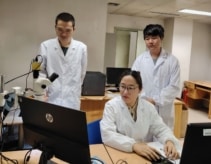
Most modern computers – from primitive room-filling behemoths like the ENIAC to the smartphone in your pocket – are built according to a set of principles laid out by the mathematician John von Neumann in 1945. This von Neumann architecture, as it is known, incorporates many familiar elements, including a central processing unit, a memory for storing data and instructions, and input and output devices. Despite its ubiquity, though, von Neumann’s model is not the only way of building a computer, and for some applications, it is not the most desirable, either.
One emerging alternative is known as neuromorphic computing. As the name implies, neuromorphic computers are inspired by the architecture of the human brain and use highly connected artificial neurons and artificial synapses to simulate the brain’s structure and functions. For researchers like Le Zhao of China’s Qilu University of Technology, this neuromorphic model offers a fantastic opportunity to develop a new paradigm for computing – as long as we can develop artificial neurons and synapses that have the right properties.
In a recent paper published in Materials Futures, Zhao and colleagues describe how to use a memristor – essentially a switch that “remembers” which electric state it was in, even after its power is turned off – to emulate the function of a synapse in the brain. Here, he explains the team’s goals and plans.
What was the motivation of your research?
We are trying to develop neuromorphic systems that can surpass the current von Neumann computing architecture in terms of lowering energy consumption and increasing intelligence. Many of these systems demand electronic devices with multiple dynamics to achieve the desired functions. These diverse requirements, such as the co-existence of volatile and non-volatile switching dynamics, can hardly be achieved in individual memristive devices.

For this reason, the realization of targeted applications usually relies on tailored neural circuit designs composed of memristors with various dynamic properties. The problem is that this reliance on multiple tailored designs limits the development of compact and low-power neuromorphic systems. It is therefore of great importance to integrate multiple inherent dynamics into an individual device and develop multi-functional neuromorphic devices, such as a versatile synaptic emulator that can fully simulate the functions of biological synapses using just a single device.
The benefits of doing this are that the universality of the device can increase the computational complexity of the system without escalating the material and area budget. In this way, we can achieve highly efficient computing in biological nervous systems. The development of devices with more complex dynamic properties is thus a crucial approach toward realizing a brain-like computing system.
What did you do in the paper?
We have successfully developed an artificial synapse with multiple synaptic functions and highly adaptive characteristics based on a simple SrTiO3/Nb: SrTiO3 heterojunction. This artificial synapse supports many functions of synaptic learning, including short-term/long-term plasticity (STP/LTP), the transition from STP to LTP, learning–forgetting–relearning behaviours, associative learning and dynamic filtering. We implemented all of these functions in a single device in a bio-realistic way.

Quantum memristor paves the way for neuromorphic quantum computing
Our multi-functional synaptic emulator has an advanced computing capability even though it is based on a simple heterostructure. We therefore believe it shows great potential for applications in compact, low-power neuromorphic computing systems. Our results suggest that our artificial synapses, which combine diverse synaptic functions with a simple structure, are potential candidates for versatile neuromorphic computing devices.
What do you plan to do next?
We will work on developing more versatile artificial synapse devices. For example, we are developing multimodal synaptic devices that can simulate the learning and memory process of the human brain by synergizing various perceptions such as vision, smell and hearing.
